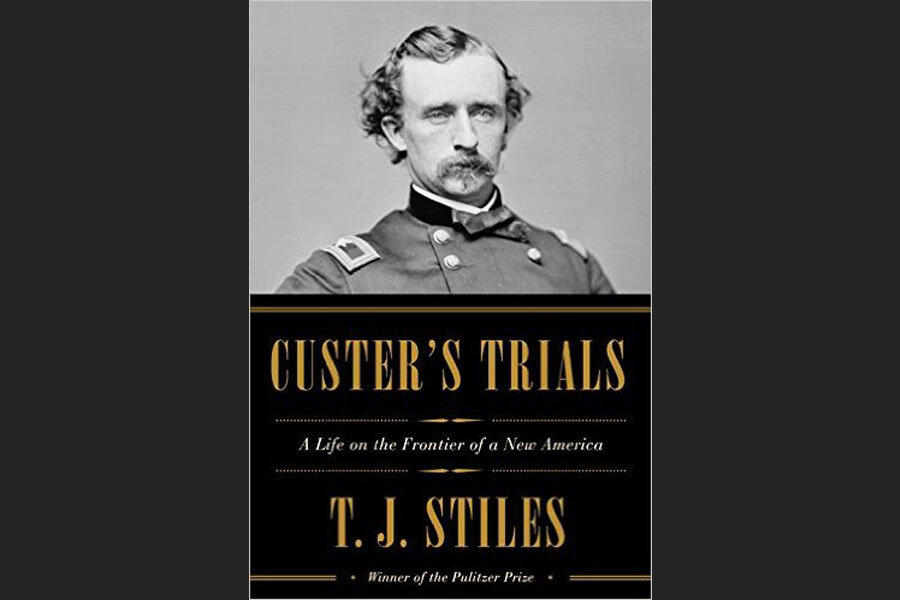'Custer's Trials' portrays a man at odds with himself and his times
Loading...
George Armstrong Custer was killed, along with five companies of men in the 7th Cavalry under his command, during the Battle of Little Bighorn in 1876. Since then, more books have been written about Custer than Elvis, and as more information comes out, little of it is flattering. Custer captures our attention because he was audacious on the field of battle, and he was natty: the golden locks, the buckskin, the rakish hat. Plus, he was a bad boy, and bristled at (selected) authority.
Custer’s Trials, by T.J. Stiles, is a good and meaty biography, with as many digressions as there are condiments for hot dogs. Well informed by primary-source material, complemented by an array of illuminations all Stiles’s own (although he also gives attributive credit to others including Evan Connell, Robert Utley, and Michael Elliott), Stiles’s book depicts Custer’s boyishness as a melancholy affair, and not just because the rambunctious boy turned into a dangerous and opportunistic bigot. For Stiles, Custer personifies America’s youth slipping away.
Stiles sets the scene: Custer was the old way confronting new circumstances. He was a sword-wielding cavalryman when warfare had already moved into the age of mechanical slaughter.
“This moment is when the modern came. The emerging new order was industrial, corporate, scientific, and legal – diminishing the individualistic, the romantic, and the heroic in American culture,” writes Stiles.
Custer was an uneasy and complicated character: a devoted husband and a crass philanderer, a man of honor who got himself court-martialed twice, and a dyed-in-the-wool racist/white supremacist who fought bravely for emancipation. He was also reckless and toadying with politicians even as he projected an offhanded unaffectedness that shattered before his fear of neglect. He was a horse thief, an extrajudicial executioner, and a gambling addict. He left his comrades in mortal hot spots, flogged his men after it had become illegal, conducted a mock execution, and – many would say – committed murder. He was violent, scornful, and wickedly insecure, which is a combination about as stable as nitroglycerin. Boom.
As much as Stiles gets into Custer’s head, he also charts the man’s progress on the ground. Custer was the John Belushi of West Point, a mischief-maker who graduated 34th out of 34 and racked up a colossal collection of 726 demerits. During the Civil War, Custer displayed an inordinate fondness for battle. He was promoted to brigadier general from lieutenant – which is as dandy a trick as amassing 726 demerits – and he understood that promotion to mean he led from the front.
He fought at Shiloh, Antietam, the Wilderness, and Gettysburg, at Yellow Tavern, Haw’s Shop, Cold Harbor, Louisa Courthouse, Dinwiddie Courthouse, Five Forks, Trevilian Station, and countless other murderous crossroads. “Custer acted out of ... an antebellum sense of gallantry. He wished to be seen as the embodiment of manly virtues – the noble soldier who confronts his foe and protects the weak.” Blind luck, Stiles argues, as others have, also had a hand in the matter.
Here is Custer maneuvering for political office. Here he is taking over a command in Texas fighting a band of Confederates who just wouldn’t give up long after Lee had surrendered. Here he is on Wall Street trying to sell shares in a silver mine, then on to another command in Kansas: “The relationship between the United States and the high-plains nations was one of an industrializing, rapidly growing, and aggressive society overwhelming far smaller and less powerful peoples.... The very existence of the United States was predicated on the dispossession of the indigenous. If Custer was wrong, ultimately it was because the nation was wrong,” writes Stiles. “But he was no outlier.”
He was, however, a bigot to the last – “Custer considered black suffrage an absurdity” – nor should we forget his treatment of the Cheyenne, Dakota, Oglala, Miniconjou, Sans Arc, Brulé, and Hunkpapa tribes, and Sitting Bull, Red Cloud, and Crazy Horse.
As events conspire to end Custer’s run of luck, Stiles is busy sketching the background to Custer’s life: in the Dakota Territory, the Black Hills (where gold, or even the suggestion of it, changes everything), Little Bighorn, and the twilight of the frontier.
The self-image of the chivalrous fighter needs the local, traditional, and customary. As the institutional and bureaucratic take center stage, the fighter becomes a soldier – organized, standardized, rationalized – and the questionable strain of the romantic is lost. Custer was at fundamental odds with his time, and that would unfold sadly, appallingly, into his being at odds with himself and all those he pulled down with him.
Peter Lewis is a frequent contributor to the Monitor books section.








